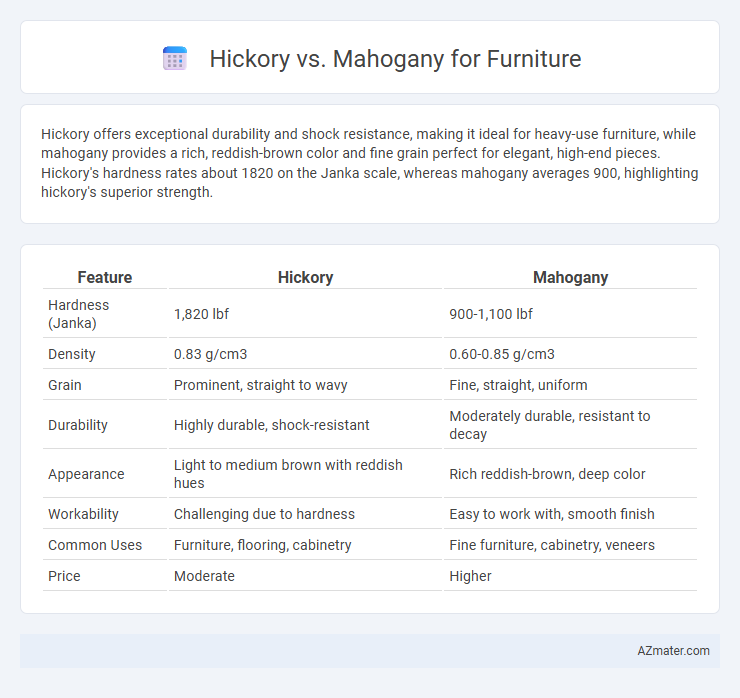Hickory offers exceptional durability and shock resistance, making it ideal for heavy-use furniture, while mahogany provides a rich, reddish-brown color and fine grain perfect for elegant, high-end pieces. Hickory's hardness rates about 1820 on the Janka scale, whereas mahogany averages 900, highlighting hickory's superior strength.
Table of Comparison
| Feature | Hickory | Mahogany |
|---|---|---|
| Hardness (Janka) | 1,820 lbf | 900-1,100 lbf |
| Density | 0.83 g/cm3 | 0.60-0.85 g/cm3 |
| Grain | Prominent, straight to wavy | Fine, straight, uniform |
| Durability | Highly durable, shock-resistant | Moderately durable, resistant to decay |
| Appearance | Light to medium brown with reddish hues | Rich reddish-brown, deep color |
| Workability | Challenging due to hardness | Easy to work with, smooth finish |
| Common Uses | Furniture, flooring, cabinetry | Fine furniture, cabinetry, veneers |
| Price | Moderate | Higher |
Overview of Hickory and Mahogany
Hickory is a dense, strong hardwood known for its exceptional durability and shock resistance, making it ideal for furniture subjected to heavy use such as chairs and rustic pieces. Mahogany is prized for its rich, reddish-brown color, fine grain, and smooth texture, offering an elegant and luxurious finish preferred in high-end furniture and cabinetry. Both woods have unique properties: hickory excels in strength and wear resistance, while mahogany is favored for its aesthetic appeal and ease of carving.
Physical Characteristics Comparison
Hickory furniture is renowned for its exceptional hardness and density, boasting a Janka hardness rating of approximately 1,820, making it highly resistant to dents and wear. Mahogany, with a Janka hardness around 800-900, is softer but prized for its smooth texture and rich reddish-brown color, which deepens over time. Hickory exhibits prominent grain patterns with contrasting light and dark streaks, while mahogany offers a more consistent, fine-grained appearance that enhances its elegant appeal.
Durability and Strength Differences
Hickory offers exceptional strength and shock resistance, making it highly durable for furniture that withstands heavy use and impact. Mahogany provides a strong but slightly less dense wood, favored for its stability and resistance to warping, ideal for finely crafted, elegant pieces. The higher hardness rating of hickory (between 1,820 and 2,210 on the Janka scale) surpasses mahogany's (about 900 to 1,070), highlighting its superior durability for robust furniture applications.
Appearance and Grain Patterns
Hickory furniture features a striking contrast with its light and dark streaks, showcasing bold, prominent grain patterns that highlight rustic and casual styles. Mahogany offers a rich, consistent reddish-brown hue with fine, straight, and even grain, delivering an elegant and smooth appearance favored in traditional and formal furniture. Both woods provide unique aesthetics; Hickory's varied texture versus Mahogany's uniform refinement cater to different design preferences.
Workability and Ease of Crafting
Hickory offers exceptional workability due to its toughness and shock resistance, allowing craftsmen to create durable furniture with a smooth finish after proper sanding and finishing. Mahogany, renowned for its fine grain and uniform texture, is easier to carve and shape, providing a more refined detail in intricate designs and assembling joints. Both woods require decent tools, but mahogany typically demands less effort in cutting and shaping, making it preferable for detailed woodworking projects.
Common Furniture Uses
Hickory is commonly used for durable furniture such as chairs, cabinets, and flooring due to its high strength and shock resistance. Mahogany is favored for fine furniture, including tables, desks, and decorative pieces, owing to its rich color, smooth grain, and excellent workability. Both woods offer distinct aesthetics and performance, with hickory suited for rustic, heavy-use items and mahogany ideal for elegant, handcrafted designs.
Cost and Availability Analysis
Hickory furniture generally offers a more affordable option compared to mahogany, with prices typically 20-40% lower due to its wider availability and faster growth rate. Mahogany, prized for its rich color and durability, commands higher costs because of limited supply and slower maturation, often sourced from tropical regions. Availability of hickory is more consistent across North America, while mahogany's availability is restricted, influencing both procurement time and overall pricing in furniture manufacturing.
Maintenance and Longevity
Hickory furniture requires regular oiling and protection from moisture to maintain its durability and resist cracking, making it moderately high-maintenance. Mahogany is naturally resistant to decay and insect damage, needing less frequent maintenance such as polishing to preserve its rich color and smooth finish. Both woods offer excellent longevity, but mahogany's density and resilience typically provide a longer lifespan with less upkeep.
Environmental Impact and Sustainability
Hickory is considered more sustainable due to its faster growth rate and abundance in North American forests, allowing for responsible harvesting with less environmental strain. Mahogany, often sourced from tropical rainforests, faces significant sustainability challenges due to slower growth, illegal logging, and habitat destruction. Choosing hickory supports reduced deforestation rates and promotes sustainable forestry practices, while mahogany demands stricter certification standards to ensure environmental responsibility.
Which Wood is Better for Furniture?
Hickory offers exceptional strength and durability, making it ideal for heavy-use furniture like tables and chairs, while mahogany is prized for its rich color and smooth grain, providing a luxurious aesthetic perfect for decorative pieces. Hickory's hardness rating of 1820 on the Janka scale surpasses mahogany's 800-900, ensuring greater resistance to dents and wear, whereas mahogany's stability and fine texture make it easier to carve and finish. Choosing between hickory and mahogany depends on whether durability or elegance is the priority for the furniture piece.

Infographic: Hickory vs Mahogany for Furniture
 azmater.com
azmater.com